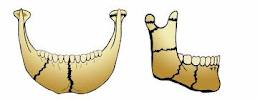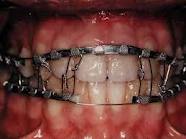We have discussed the principles of management of fractures in Fracture of the Lower Jaw-Part I. In this article we will be discussing a little in depth regarding the management of Lower jaw fractures, or mandibular fractures.
 PRINCIPLES OF MANAGEMENT OF FRACTURES:
PRINCIPLES OF MANAGEMENT OF FRACTURES:
- Reduction of the fracture-Reduction can be done in 2 days: Open Reduction or Closed Reduction, as will be discussed below
- Fixation & stabilization of the fracture-Direct or Indirect
- Immobilization of segments at fracture site
- Occlusion restored-to allow the patient to bite in his original position
- Infection eradicated/prevented-infection can prevent or delay healing, thus it is of essence that infection be avoided.
TREATMENT OPTIONS FOR MANDIBULAR FRACTURE
- No treatment (conservative management)
- Closed reduction
- Open reduction internal fixation (ORIF)
Reduction of Fracture
Can be closed or open reduction
Closed reduction
-In closed reduction, there is no direct opening/exposure/ manipulation/visualization of the fracture  area
–Occlusion is used as a guide, in the sense that the teeth are brought into occlusion and tied together (i.e. intermaxillary fixation, or IMF) by means of archbars & tie wires or elastics, or tie wires alone (eg: eyelets) No attempt is made to directly approximate the fracture site, hence it is also an indirect way of fixing the fracture segments together ( ie indirect fixation)
It is thus important to recognize any pre-existing occlusal abnormalities such as a gap between the upper and lower front teeth when the patient bites in his usual occlusion (anterior open bite) or a class III occlusion (whereby the lower dentition is relatively more protruded compared to the upper dentition.
Open reduction
Open reduction is a surgical procedure done by direct visualization of the fracture area, and the fracture segments are re-approximated manually and fixed with the help of titanium screws & plates. If open reduction is done, the teeth do not need to be tied together for as long a time as in closed reduction.
-The surgical approach can be from inside of the mouth (intra-oral) or externally through the facial skin (extra-oral), depending on the site of fracture and accessibility. Eg, fracture of the parasymphysis and symphysis are often approached intra-orally, while fracture at the angle or ramus of the mandible are approached extra-orally.
The common approach in management of a mandibular fracture is through open reduction and internal fixation (ORIF).
ADVANTAGES AND DISADVANTAGES
Advantages of open reduction (or disadvantages of closed reduction)
- Bone fragments re-approximated exactly by direct visualization. This promotes primary bone healing, and thus, absolute stability.
- Decreased period of time that the upper and lower teeth are tied together (immobilization). Therefore, this allows early return to normal function of the mouth (i.e. better speech, diet, oral hygiene)
- Open reduction is the option of choice in patients with medical conditions such as seizures, neurological/psychological disorders, gastrointestinal tract disorders (esp gastritis).
Disadvantages of open reduction (or advantages of closed reduction)
- More expensive(the plates & screws are made of titanium)
- Foreign body left in body (plates and screws are often not removed from the body. If they are to be removed, a second surgery is required)
- Need operation room and equipment in most cases
- May leave unsightly scars if the fixation is done from the extra-oral approach.
- There is some risk to the neurovascular structures and teeth/tooth buds, as drills and screws penetrate the jaw bone.
- Require specialized skills for placing plates & screws.
Fixation & Stabilization
-Direct vs Indirect: Direct fixation is done using screws and plates placed against the fracture site to directly prevent it from movement. Indirect fixation is done by intermaxillary fixation (IMF). When the occlusion is tied together in its original bite, the fracture segments are automatically approximated together without any direct fixing of the fracture site.
Direct fixation can be: Intraoral vs Extraoral: Intraoral fixation devices include plates and screws, while extraoral fixation can be seen as metal bars protruding out of the skin after the operation.
Immobilization
The period of immobilization depends on type of fracture & bone involved:
Eg:-mandible fracture(closed reduction): 4-6 weeks
-Mandible fracture (open reduction): 2 weeks is sufficient
-condyle fracture: 2-3 weeks (condyles should not be fixed for too long a period of time for fear of TMJ problems in the long run due to bony fusion of the condyle process (known as “ankylosis”).
Factors affecting choice of treatment
- Patient factors (eg cost, duration of intermaxillary fixation, medical condition, occupation that makes a long period of immobilizationg very inconvenient etc.)
- Type of fracture (Some fractures do not require active treatment, such as condylar fracture)
- Skill of surgeon
- Availability of hardware and equipments
Complications of fracture
- Delayed union: often due to infection
- Malunion/malocclusion: fracture segments join together in an abnormal position.
- Non-union: often due to infection
- Infection
- Nerve parasthesia/numbness (eg. inferior alveolar nerve)
- Trismus/TMJ problems

